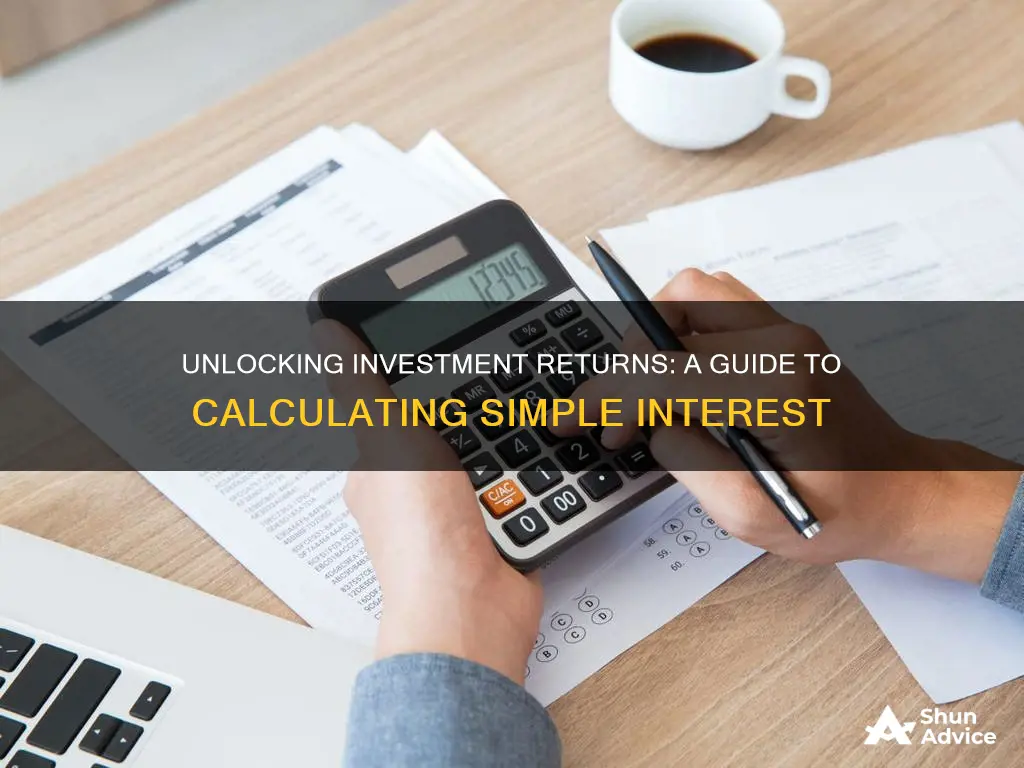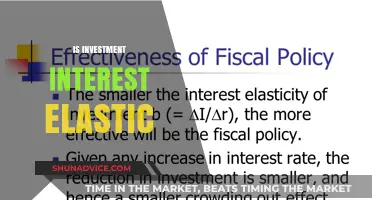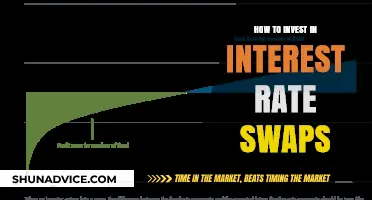
Understanding the simple interest rate on your investments is a crucial step in managing your financial growth. Whether you're a seasoned investor or just starting, knowing how to calculate this rate can help you make informed decisions about your money. Simple interest is a straightforward calculation that can be applied to various investment vehicles, such as savings accounts, bonds, or even certain loans. This guide will provide a clear and concise method to determine the simple interest rate, ensuring you can assess the potential returns on your investments and make the most of your financial resources.
What You'll Learn
- Understanding Interest Rates: Learn how interest rates impact investment returns
- Simple Interest Formula: Master the formula for calculating simple interest
- Interest Calculation Steps: Follow a step-by-step guide to calculate interest
- Interest Rate Factors: Explore factors affecting interest rates on investments
- Real-World Examples: See how simple interest applies to investment scenarios

Understanding Interest Rates: Learn how interest rates impact investment returns
Interest rates play a crucial role in the world of finance and investing, and understanding how they work is essential for anyone looking to grow their wealth. When you invest your money, whether in a savings account, bonds, or other financial instruments, you're essentially lending your funds to a financial institution or the government. In return, you earn interest, which is a percentage of your investment. This is where interest rates come into play, as they determine the amount of interest you'll receive.
To calculate the simple interest rate on an investment, you need to know the formula: Interest = Principal * Rate * Time. Here, 'Principal' is the initial amount of money you invest, 'Rate' is the interest rate as a decimal, and 'Time' is the duration of your investment in years. By rearranging this formula, you can solve for the rate, which will give you the simple interest rate. For example, if you invest $1000 at an interest rate of 5% for one year, the interest earned would be $50, and the rate can be calculated as 0.05 (5% as a decimal) * 1 year = 0.05.
Now, let's explore how interest rates impact investment returns. When interest rates rise, borrowing becomes more expensive, and people tend to save more. As a result, the demand for loans and investments decreases, which can lead to lower returns on your investments. On the other hand, when interest rates fall, borrowing becomes cheaper, encouraging more spending and investment. This increased demand can drive up the value of your investments, potentially resulting in higher returns.
Understanding these dynamics is crucial for investors as it helps them make informed decisions. For instance, if you're considering investing in bonds, rising interest rates might make newly issued bonds more attractive as they offer higher yields. Conversely, if you already hold bonds with lower interest rates, rising rates could impact their value. Similarly, for those investing in stocks, interest rate changes can affect the overall market sentiment and, consequently, stock prices.
In summary, interest rates are a critical factor in investment decisions. By calculating simple interest rates and understanding their impact on investment returns, investors can navigate the financial markets more effectively. It empowers individuals to make strategic choices, whether it's timing their investments, diversifying their portfolios, or seeking opportunities that align with their financial goals.
Interest Rate Evolution: From Primary to Investment
You may want to see also

Simple Interest Formula: Master the formula for calculating simple interest
To calculate simple interest, you can use the following formula:
Simple Interest = (Principal x Rate x Time) / 100
Where:
- Principal is the initial amount of money invested or borrowed.
- Rate is the interest rate expressed as a decimal (e.g., 5% becomes 0.05).
- Time is the duration of the investment or loan in years.
This formula is a straightforward way to determine the interest earned or charged on a simple interest loan or investment. It's important to note that simple interest is calculated only on the principal amount, not on the accumulated interest. This means that the interest earned or charged remains constant throughout the loan or investment period.
For example, let's say you invest $1,000 at a simple interest rate of 4% for 2 years. Using the formula:
Simple Interest = ($1,000 x 0.04 x 2) / 100 = $8
So, the interest earned on this investment would be $8. This calculation is useful for understanding the potential returns or costs associated with simple interest investments or loans.
Mastering this formula will enable you to quickly calculate simple interest, helping you make informed decisions about your investments and financial planning. It's a fundamental concept in finance and understanding it can be beneficial for assessing the growth or cost of your money over time.
Navigating Fixed-Rate Investments: Understanding the Impact of Rising Interest Rates
You may want to see also

Interest Calculation Steps: Follow a step-by-step guide to calculate interest
To calculate the simple interest on an investment, you can follow these steps:
- Identify the Principal Amount: The first step is to determine the initial amount of money invested or borrowed, often referred to as the principal. This is the starting point for your interest calculation. For example, if you invest $5,000 in a savings account, the principal amount is $5,000.
- Determine the Interest Rate: You need to know the interest rate, which is typically expressed as a percentage. This rate represents the cost of borrowing or the reward for lending money. For instance, if the interest rate is 5%, it means for every $100, you will earn $5 in interest over a specific period.
- Establish the Time Period: Define the duration for which the interest is calculated. This could be a year, a month, or any other time frame. For simplicity, let's assume you want to calculate the interest for one year.
- Apply the Simple Interest Formula: The formula for simple interest is: Interest = Principal × Rate × Time. Multiply the principal amount by the interest rate (in decimal form) and then by the time period. For example, if the principal is $5,000, the rate is 5% (or 0.05 as a decimal), and the time is 1 year, the calculation would be: Interest = $5,000 × 0.05 × 1 = $250. So, you would earn $250 in interest over that year.
- Consider Compounding (Optional): If the interest is compounded, meaning it is added to the principal and earns interest in subsequent periods, the calculation becomes more complex. You would need to know the compounding frequency (annually, semi-annually, etc.) and apply the compound interest formula. However, for simple interest, the above steps provide a straightforward method to determine the interest earned.
By following these steps, you can easily calculate the simple interest on your investments, helping you understand the growth or cost associated with your financial decisions. Remember, simple interest is a basic concept, and more complex financial products may involve compound interest or other factors.
Understanding Investment Interest: What It Is and How It Works
You may want to see also

Interest Rate Factors: Explore factors affecting interest rates on investments
When considering investments, understanding the factors that influence interest rates is crucial for making informed financial decisions. Interest rates play a significant role in determining the returns on your investments, and several key elements can impact these rates. Here's an exploration of the factors that affect interest rates on investments:
Economic Conditions: The state of the economy is a primary determinant of interest rates. Central banks and financial institutions often adjust rates in response to economic indicators. During periods of economic growth, central banks might increase interest rates to control inflation and prevent the economy from overheating. Conversely, in a recession, they may lower rates to stimulate borrowing and investment. Economic factors such as GDP growth, inflation rates, and employment levels are closely monitored to make these decisions.
Inflation: Inflation is a critical factor as it erodes the purchasing power of money over time. When inflation is high, the real value of savings and investments decreases. To combat this, central banks may raise interest rates, making borrowing more expensive and encouraging people to spend or invest their money. Higher interest rates can help control inflation by reducing the amount of money in circulation.
Credit Risk and Creditworthiness: The creditworthiness of the borrower or the investment vehicle directly impacts interest rates. Lenders assess the risk associated with lending money to individuals or entities. A higher credit risk, often associated with a lower credit score or a higher default probability, typically results in higher interest rates. Investors with a strong credit history and a low default risk may secure more favorable interest rates on loans or investments.
Market Demand and Supply: The principles of supply and demand also apply to interest rates. When there is a high demand for loans or investments, lenders may increase interest rates to attract borrowers or investors. Similarly, during periods of low demand, lenders might offer lower rates to encourage borrowing. Market dynamics and the availability of funds influence the interest rates offered by financial institutions.
Government Policies and Regulations: Government interventions in the financial market can significantly impact interest rates. Fiscal and monetary policies, such as tax incentives, subsidies, or changes in reserve requirements, can affect lending and borrowing costs. Additionally, regulations imposed by financial authorities may influence the behavior of banks and investors, ultimately shaping interest rate trends.
Understanding these factors can help investors and borrowers make strategic decisions regarding their investments and loans. By staying informed about economic trends, market dynamics, and regulatory changes, individuals can navigate the complex world of interest rates and optimize their financial strategies.
Economic Growth, Lower Rates: The Investment Boost
You may want to see also

Real-World Examples: See how simple interest applies to investment scenarios
Let's explore some real-world examples to illustrate how simple interest works in investment scenarios.
Example 1: Savings Account
Imagine you deposit $5,000 into a savings account with an annual simple interest rate of 3%. After one year, your account balance will be calculated as follows:
- Principal (initial deposit): $5,000
- Interest earned: $5,000 0.03 = $150
- Total balance after one year: $5,000 + $150 = $5,150
In this case, the interest earned is directly proportional to the principal amount and the interest rate. You can calculate the interest earned for any given period by multiplying the principal, interest rate, and time (in years).
Example 2: Bond Investment
You purchase a bond with a face value of $1,000 and an annual coupon rate of 5%. The coupon rate represents the simple interest you'll receive as periodic payments.
- Annual coupon payment: $1,000 0.05 = $50
- This $50 payment will be received annually for the bond's maturity period.
To calculate the total interest earned over the bond's life, you can multiply the coupon payment by the number of years until maturity.
Example 3: Loan Repayment
You borrow $2,000 from a friend at a simple interest rate of 4% for 6 months.
- Interest calculated: $2,000 0.04 0.5 = $40
- Total amount to be repaid: $2,000 (principal) + $40 (interest) = $2,040
Here, the interest is calculated based on the principal amount borrowed and the interest rate, regardless of the repayment schedule.
Example 4: Investment Growth
You invest $10,000 in a fund that offers a simple interest rate of 2% annually.
- After 5 years: $10,000 0.02 5 = $1,000 in interest earned
- Total value after 5 years: $10,000 (initial investment) + $1,000 (interest) = $11,000
This example demonstrates how simple interest can be used to calculate the growth of an investment over time.
Remember, simple interest is a straightforward calculation method, making it easier to understand and predict the returns on your investments.
Unraveling the Dollar's Rate Impact: A Guide to Investing Strategies
You may want to see also
Frequently asked questions
Simple interest is a basic method of calculating interest, where interest is calculated as a percentage of the principal amount for a specific period. It is a straightforward way to earn interest on your investments without compounding.
To calculate the simple interest rate, you can use the formula: Interest = Principal * Rate * Time. Here, the interest rate is expressed as a decimal, so if you have a 5% interest rate, it becomes 0.05. The time is typically in years.
Sure, let's say you invest $1,000 at a simple interest rate of 4% for 2 years. The calculation would be: Interest = $1,000 * 0.04 * 2 = $80. So, you earn $80 in interest over the 2-year period.
Simple interest only applies to the principal amount, meaning the interest earned does not accumulate and add to the principal. In contrast, compound interest calculates interest on the principal and any accumulated interest, resulting in exponential growth over time.
Yes, simple interest is easier to understand and calculate, making it more transparent for investors. It is also useful for comparing different investment options with the same principal amount and time frame, as it provides a clear picture of the interest earned without the complexity of compounding.







